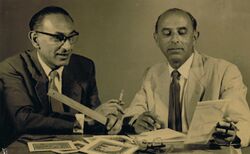Graphic designer
 From HandWiki - Reading time: 4 min
From HandWiki - Reading time: 4 min
 Gabriel and Maxim Shamir, important Israeli graphic designers of the 20th century. | |
| Occupation | |
|---|---|
| Names | Graphic designer |
Occupation type | Profession |
Activity sectors | Advertising, book design, branding, illustration, page layout, typography, webcomic, web design, programming, digital animation, 3D modeling |
| Description | |
| Competencies | Technical knowledge, cultural relevance |
Related jobs | Production artist, graphic artist, website designer, desktop publishing |

A graphic designer is a professional who practices the discipline of graphic design, either within companies or organizations or independently. They are professionals in design and visual communication, with their primary focus on transforming linguistic messages into graphic manifestations, whether tangible or intangible.[1][2] They are responsible for planning, designing, projecting, and conveying messages or ideas through visual communication.[3] It is one of the most in-demand professions with significant job opportunities, as it allows leveraging technological advancements and working online from anywhere in the world.[4][5]
Generally, a graphic designer works in areas such as branding, corporate identity, advertising, technical and artistic drawing, multimedia, etc. It is a profession that exposes individuals to various academic fields during their university career,[6][7][8] because they need to understand human anatomy, psychology, photography, painting and printing techniques, mathematics, marketing, digital animation, 3D modeling, and some professionals even complement their skills with programming,[9] providing a comprehensive view of a company by addressing the three essential factors evaluated: structure, team, and product.[10]
Professional requirements for graphic designers vary from one place to another. Designers must undergo specialized training, including advanced education and practical experience (internship) to develop skills and expertise in the workplace, which is necessary to obtain a credential that allows them to practice the profession.[11][12] Practical, technical, and academic requirements to become a graphic designer vary by country or jurisdiction, although the formal study of design in academic institutions has played a crucial role in the overall development of the profession.[13][14][15]
Qualifications
Designers should be able to solve visual communication problems or challenges. In doing so, the designer must identify the communications issue, gather and analyze information related to the issue, and generate potential approaches aimed at solving the problem. Iterative prototyping and user testing can be used to determine the success or failure of a visual solution.[buzzword] Approaches to a communications problem are developed in the context of an audience and a media channel. Graphic designers must understand the social and cultural norms of that audience in order to develop visual solutions[buzzword] that are perceived as relevant, understandable and effective.[16]
Graphic designers should also have a thorough understanding of production and rendering methods. Some of the technologies and methods of production are drawing, offset printing, photography, and time-based and interactive media (film, video, computer multimedia). Frequently, designers are also called upon to manage color in different media.[16] For instance, graphic designers use different colors for digital and print advertisements. RGB — standing for red, green, blue — is an additive color model used for digital media designs. However, the CMYK color model is made up of subtractive colors — cyan, magenta, yellow, and black — and used in designing print media. The reason for the different models is that when designing print ads, colors look different on the screen and when printed onto paper. For example, the colors appear darker on paper than on screen. [17]
See also
- Graphic design occupations
- List of graphic designers
- Mood board
References
- ↑ Flavin, Brianna (October 17, 2023). "What Is Graphic Design? A Beginner's Guide to This Creative Career". Rasmussen University. https://www.rasmussen.edu/degrees/design/blog/what-is-graphic-design/.
- ↑ Jessica Helfand. "What is graphic design". AIGA. http://www.aiga.org/content.cfm/what-is-design. "it is the art of visualizing ideas"
- ↑ Simmons, Liz; Beagle, Veronica (July 3, 2023). "How To Become A Graphic Designer: A Step-By-Step Guide". Forbes. https://www.forbes.com/advisor/education/become-graphic-designer/.
- ↑ Malinsky, Gili (March 15, 2023). "This skill is in ‘giant’ demand—and can pay up to $145 an hour as a side hustle". CNBC. https://www.cnbc.com/2023/03/15/how-to-get-graphic-design-jobs.html.
- ↑ "Is Graphic Design a Good Career?". National University. https://www.nu.edu/blog/is-graphic-design-a-good-career/.
- ↑ Vise, Kristen. "An Interdisciplinary Approach to Graphic Design". College of Liberal Arts. https://libarts.olemiss.edu/an-interdisciplinary-approach-to-graphic-design/.
- ↑ Castro Arbeláez, María Alejandra (September 14, 2023). "Graphic design and psychology: how are they related?". La Mente es Maravillosa. https://lamenteesmaravillosa-com.translate.goog/diseno-grafico-y-psicologia/?_x_tr_sl=es&_x_tr_tl=en&_x_tr_hl=es&_x_tr_pto=wapp&_x_tr_hist=true.
- ↑ "The importance of geometry in graphic design". Universidad Intercontinental. November 28, 2017. https://www-uic-mx.translate.goog/noticias/la-importancia-la-geometria-diseno-grafico/?_x_tr_sl=es&_x_tr_tl=en&_x_tr_hl=es&_x_tr_pto=wapp.
- ↑ "What is the importance of web design for your audience?". Smart Insights. January 3, 2020. https://www.smartinsights.com/user-experience/website-design/what-is-the-importance-of-web-design-for-your-audience/.
- ↑ "Business Model Canvas: Explained with Examples | Creately" (in en). 2022-06-20. https://creately.com/guides/business-model-canvas-explained/.
- ↑ Grey, Sheryl; Beagle, Veronica (July 3, 2023). "Graphic Design Careers: A Complete Guide". Forbes. https://www.forbes.com/advisor/education/graphic-design-careers/.
- ↑ Tompkins, Jeff; Beagle, Veronica (July 3, 2023). "Bachelor’s Degrees In Graphic Design: Everything You Need To Know". Forbes. https://www.forbes.com/advisor/education/graphic-design-bachelors-degree/.
- ↑ Quintela, Pedro. "From the shadow to the centre: Tensions, contradictions and ambitions in building graphic design as a profession". University of Coimbra. https://eg.uc.pt/bitstream/10316/33004/1/From%20the%20shadow%20to%20the%20centre%20tensions%2C%20contradictions%20and%20ambitions%20in%20building%20graphic%20design%20as%20a%20profession.pdf.
- ↑ Khaled Nabil, Al-Momani (25 August 2020). "Characteristics of Design as an Academic and Creative Discipline". Kne Social Sciences (Ural Federal University): 294–298. doi:10.18502/kss.v4i11.7560.
- ↑ Bravo, Rafael Ángel (4 March 2016). "Vigencia de la Bauhaus en la formación académica de los diseñadores gráficos" (in es). Francisco José de Caldas District University. https://revistas.udistrital.edu.co/index.php/c14/article/view/10133.
- ↑ 16.0 16.1 "NASAD Competencies Summary". http://www.docstoc.com/docs/110496132/NASAD-Competencies-Summary-Degree-The-BFA-in-Graphic.
- ↑ Dabner, David (2009). The new graphic design school : A foundation course in principles and practice (4th ed.). Chichester: John Wiley & Sons, Incorporated. ISBN 9780470466513.
 |
 KSF
KSF